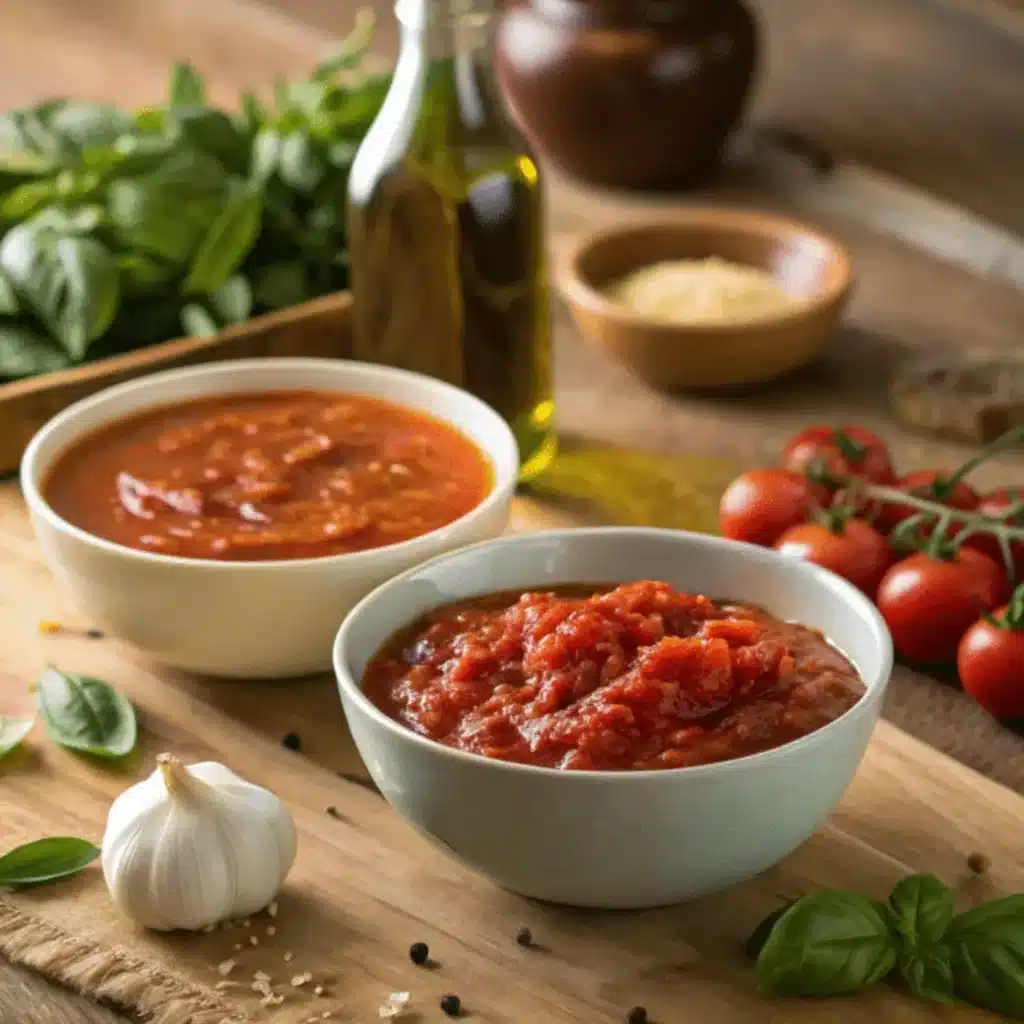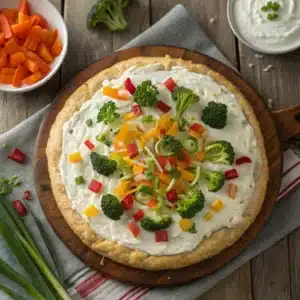Marinara vs Pizza Sauce they sound similar, but their flavors, textures, and uses couldn’t be more different. If you’ve ever wondered which one belongs on your pizza or why Nonna’s pasta tastes so rich, you’re in the right place.
The key difference? Pizza sauce is usually uncooked just pureed tomatoes and herbs, designed to cook in a hot oven. Marinara, on the other hand, is a stovetop classic, simmered slowly with garlic, onion, and olive oil for bold, layered flavor.
In this guide, we’ll explore what truly sets them apart, when to use each one, and how to make both from scratch so your next pizza or pasta night is nothing short of delicious.
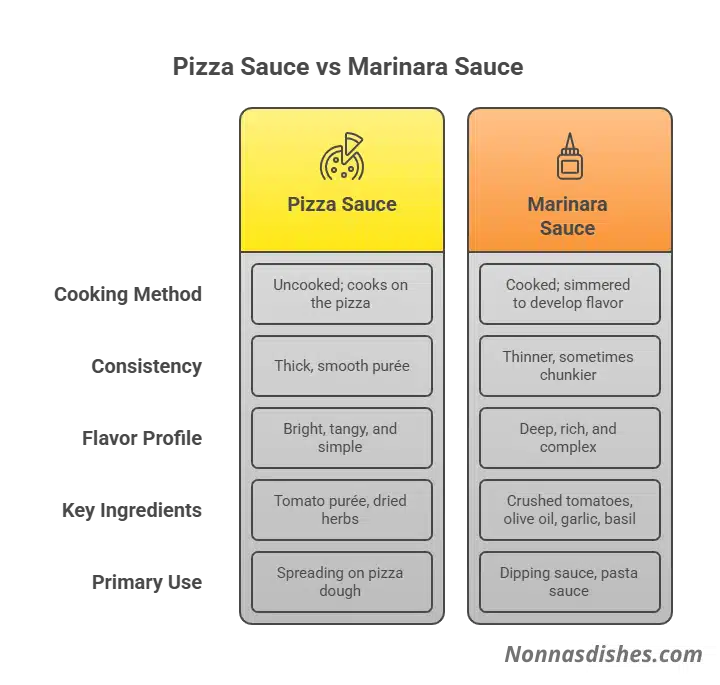
Table of Contents
Table of Contents
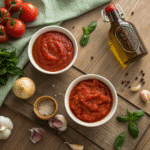
Marinara vs Pizza Sauce The Secret to Perfect Sauce
- Total Time: 30 minutes
- Yield: 2 cups 1x
- Diet: Vegetarian
Description
The difference between marinara vs pizza sauce is all in the method one’s simmered, the other’s stirred. This recipe shows you how to make both, just like Nonna Lucia would.
Ingredients
For Pizza Sauce:
1 small can tomato puree or passata
1–2 cloves garlic, finely chopped
1 tsp dried oregano
½ tsp dried basil
½ tsp salt
¼ tsp black pepper
1 tsp sugar
1 tbsp olive oil (optional)
For Marinara Sauce:
1 (28 oz) can San Marzano tomatoes, crushed or pureed
2 cloves garlic, minced
½ onion, finely diced
1 tsp dried oregano
4–5 fresh basil leaves, torn
1 tbsp extra-virgin olive oil
1 tsp salt
½ tsp black pepper
Pinch of red pepper flakes (optional)
Instructions
1. To Make Pizza Sauce:
2. Put the tomato puree in a bowl.
3. Add chopped garlic, oregano, basil, salt, pepper, and sugar.
4. Stir everything well. Add olive oil if you want it richer.
5. Let it sit for 5–10 minutes for flavors to blend.
6.
7. To Make Marinara Sauce:
8. Heat olive oil in a pan.
9. Add garlic and onion, cook until soft.
10. Pour in tomatoes. Add oregano, salt, pepper, and chili flakes.
11. Simmer covered for 15–20 minutes.
12. Turn off heat, stir in fresh basil.
13. Taste and adjust seasoning.
Notes
• If sauce is thin, simmer longer or add tomato paste.
• Blend marinara to use as pizza sauce.
• Store in fridge for 5 days or freeze up to 3 months.
- Prep Time: 10 minutes
- Cook Time: 20 minutes
- Category: Traditional Pizza Recipes
- Method: Stovetop
- Cuisine: Italian
Nutrition
- Serving Size: 1/4 cup
- Calories: 60
- Sugar: 3g
- Sodium: 300mg
- Fat: 3g
- Saturated Fat: 0.5g
- Unsaturated Fat: 2.5g
- Trans Fat: 0g
- Carbohydrates: 7g
- Fiber: 2g
- Protein: 1g
- Cholesterol: 0mg
Keywords: marinara vs pizza sauce, homemade pizza sauce, traditional marinara
Why You’ll Love Marinara vs Pizza Sauce Recipes
There’s something special about making sauce from scratch whether it’s a quick pizza night or a slow Sunday dinner. These two recipes capture the heart of Italian home cooking: simple ingredients, bold flavors, and a whole lot of love.
- Fast or Slow—You Choose: Pizza sauce comes together in minutes, no stove required. Marinara simmers for rich, deep flavor.
- Made with Pantry Staples: Tomatoes, garlic, herbs nothing fancy, just real food.
- Versatile for Any Dish: Use pizza sauce for pies, marinara for pasta, or swap them for a twist.
- Kid-Friendly & Family-Approved: My grandkids stir the pot, taste as they go, and always ask for seconds.
- Healthier Than Store-Bought: No hidden sugar, no preservatives just clean, homemade flavor.
Once you know the difference, you’ll never look at a jar of red sauce the same way again.
Ingredients for Marinara vs Pizza Sauce
When it comes to marinara vs pizza sauce, the difference isn’t just in how you cook them—it’s in what goes into them. Both are tomato-based, but each has its own distinctive flavor profile. Here’s what you’ll need:
Ingredients for Pizza Sauce (No Cooking)
- Tomato purée or passata (1 small can) – Provides a smooth, rich tomato base
- Garlic (1–2 cloves, finely chopped) – Adds a sharp, savory flavor
- Dried oregano (1 teaspoon) – Delivers that classic pizzeria aroma
- Dried basil (½ teaspoon) – A soft, herbal sweetness
- Salt (½ teaspoon) – Essential for balance
- Black pepper (¼ teaspoon) – Brings a subtle kick
- Sugar (1 teaspoon) – Offsets acidity and enhances flavor
- Olive oil (1 tablespoon, optional) – Adds a smooth, rounded finish
Ingredients for Marinara Sauce (Cooked)
- San Marzano tomatoes (28 oz can, crushed or puréed) – Sweet, low-acid, and rich in flavor
- Garlic (2 cloves, minced) – A key aromatic
- Onion (½ small, finely diced) – Adds sweetness and depth
- Dried oregano (1 teaspoon) – For bold Italian flavor
- Fresh basil (4–5 leaves, torn) – Adds brightness and freshness
- Extra-virgin olive oil (1 tablespoon) – For sautéing and richness
- Salt (1 teaspoon) – Enhances all the flavors
- Black pepper (½ teaspoon) – Adds depth
- Red pepper flakes (optional pinch) – For mild heat and complexity
These two ingredient lists reflect how simple Italian cooking can be, yet how much character each sauce develops based on preparation.
How to Make Marinara vs Pizza Sauce at Home
Both sauces are simple to make, but their preparation methods highlight their distinct purposes in Italian cooking. Follow these clear steps for perfect results.
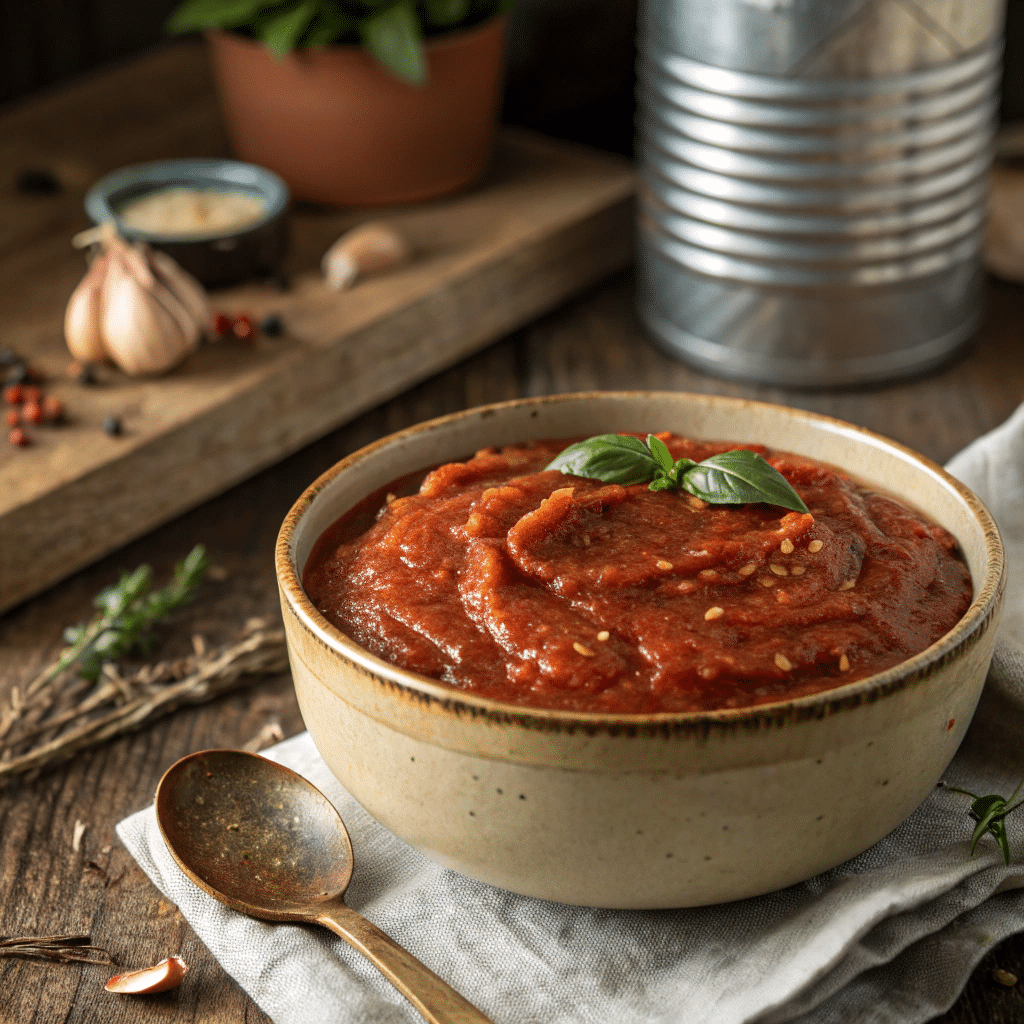
Pizza Sauce (No-Cook Method)
- Mix Ingredients: In a medium bowl, combine tomato purée, finely chopped garlic, oregano, basil, salt, black pepper, and sugar.
- Add Olive Oil (Optional): Stir in olive oil for a smoother, richer consistency.
- Blend Flavors: Mix well until the herbs are evenly dispersed. Let the sauce sit for 5 to 10 minutes so the flavors can develop.
- Taste and Adjust: Add more salt, herbs, or a touch of sugar if needed.
This raw, uncooked sauce is designed to finish cooking in the oven, resulting in a bright, fresh flavor that pairs beautifully with melted cheese and crispy dough.
Marinara Sauce (Simmered Method)
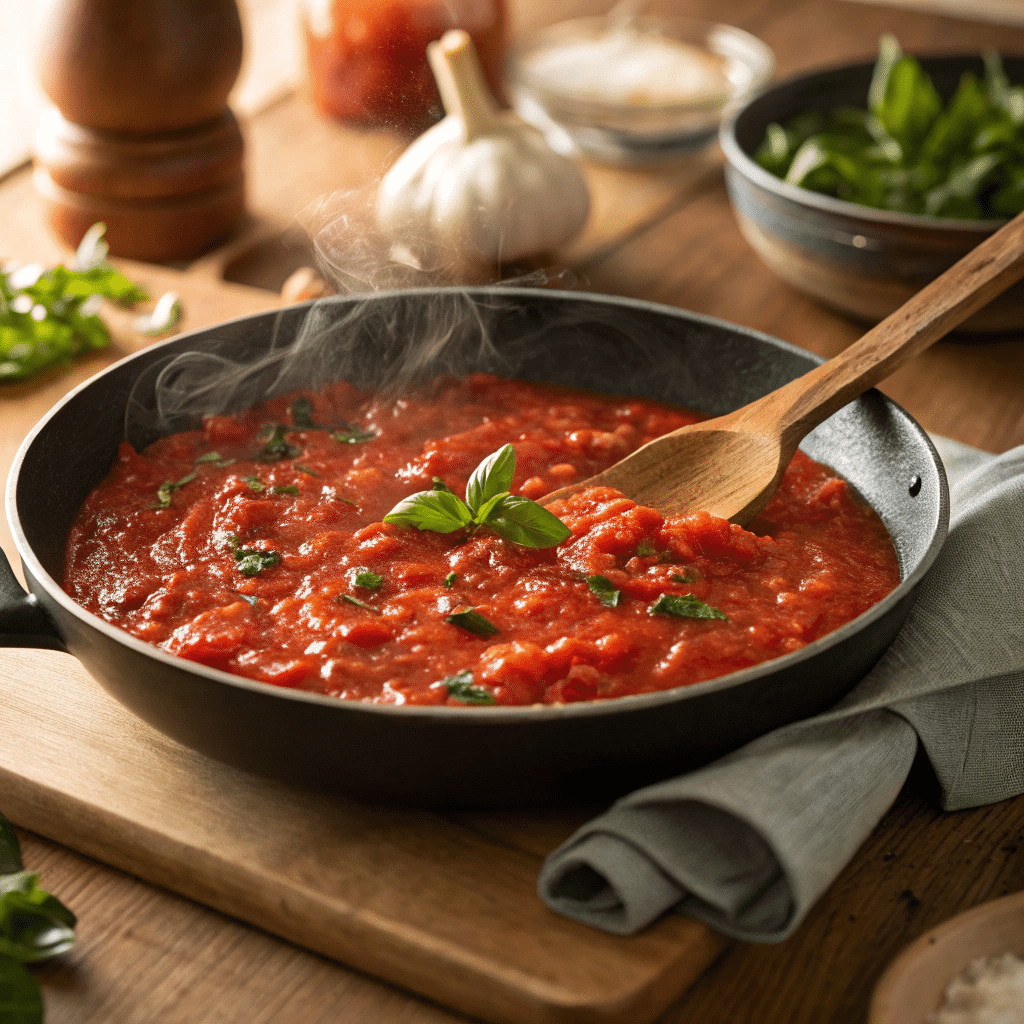
- Sauté Aromatics: In a skillet, heat olive oil over medium heat. Add the minced garlic and diced onion, and cook until soft and fragrant, about 2 to 3 minutes.
- Add Tomatoes and Seasoning: Pour in crushed tomatoes, then stir in oregano, salt, pepper, and red pepper flakes if using.
- Simmer: Reduce heat to low, cover, and let simmer gently for 15 to 20 minutes, stirring occasionally.
- Finish with Fresh Basil: Turn off the heat and stir in torn basil leaves. Taste and adjust the seasoning to your preference.
This sauce develops a deeper, more complex flavor and is perfect for pasta, dipping, or spooning over vegetables.
Expert Tips for Success
Making sauce at home is simple, but a few key techniques will take your marinara and pizza sauces from good to truly exceptional.
For Both Sauces
- Taste As You Go: Every can of tomatoes is different. Always taste your sauce and adjust the salt, herbs, or sugar as needed.
- Quality Ingredients Matter: Use the best tomatoes you can find—San Marzano for marinara, and a good passata or purée for pizza sauce.
- Let Flavors Develop: Even with the no-cook pizza sauce, letting it rest 5–10 minutes helps the herbs infuse the tomatoes more fully.
For Marinara Sauce
- Sauté Gently: Garlic and onions should soften without browning to avoid bitterness.
- Simmer Slowly: Don’t rush it. Gentle heat draws out the natural sweetness of the tomatoes.
- Use Non-Reactive Cookware: Avoid cast iron unless it’s enameled. Stainless steel or ceramic is ideal to prevent metallic taste.
For Pizza Sauce
- Keep It Thick: A too-runny sauce will make your pizza soggy. Don’t thin it unless you plan to use it for something other than pizza.
- Blend Smooth if Needed: If you prefer a perfectly smooth consistency, run it through a blender or food processor.
Troubleshooting Tips
- Too Thin? Simmer longer or add a spoonful of tomato paste.
- Too Acidic? A pinch of sugar helps balance the flavor.
- Too Bland? Add more salt or herbs gradually and stir well.
- Too Thick for Pasta? Loosen with a splash of pasta water or olive oil.
Helpful Notes for Marinara vs Pizza Sauce
These sauces are wonderfully adaptable to your pantry, dietary needs, and personal taste. Here are some easy ways to switch things up without compromising flavor.
Pizza Sauce Variations
- No Garlic? Use ¼ teaspoon garlic powder as a substitute.
- No Olive Oil? Skip it, or use another neutral oil like avocado or sunflower oil.
- Add Heat: Stir in a pinch of red pepper flakes for a spicy kick.
- Italian Seasoning Shortcut: Replace oregano and basil with 1 teaspoon of Italian seasoning.
Marinara Sauce Variations
- Fresh Tomatoes Instead of Canned: Blanch, peel, and crush ripe tomatoes if they’re in season. Use about 2 pounds for the same yield.
- No Onion? Add extra garlic, or replace with a small shallot for a milder flavor.
- Red Wine Boost: Add ¼ cup red wine after sautéing the garlic and onion. Simmer for 2 minutes before adding tomatoes.
- Make it Extra Smooth: Blend with an immersion blender or food processor after cooking for a velvety texture.
Dietary Adjustments
- Low Sodium: Use no-salt-added tomatoes and reduce added salt. Season to taste at the end.
- Vegan-Friendly: Both sauces are naturally vegan—just ensure your wine (if using) is vegan-certified.
- Gluten-Free: These recipes are gluten-free as written.
Storage and Reheating Instructions
Both marinara and pizza sauces store beautifully, making them ideal for batch cooking or prepping ahead for weeknight meals.
Refrigeration
- Storage Time: Store either sauce in an airtight container or jar in the refrigerator for up to 5 days.
- Best Containers: Glass jars, BPA-free plastic containers, or any sealed container will work well.
Freezing
- How to Freeze: Let the sauce cool completely. Pour into freezer-safe containers or resealable freezer bags, leaving some room at the top for expansion.
- Shelf Life: Keeps for up to 3 months in the freezer.
- Pro Tip: Freeze in 1-cup portions for easy thawing and meal planning.
Reheating
- Stovetop: Warm gently in a saucepan over low heat until heated through, stirring occasionally.
- Microwave: Heat in a microwave-safe bowl in 30-second intervals, stirring in between, until hot.
- If Frozen: Thaw overnight in the fridge or place the container in a bowl of cold water to speed it up.
Proper storage not only preserves the flavor it makes weeknight dinners a breeze.
Pizza Sauce vs. Pasta Sauce: What’s the Difference?
Yes, there is a significant difference. The key is that “pasta sauce” is a very broad category, while “pizza sauce” is very specific.
Marinara is one type of simple, tomato-based pasta sauce, but not all pasta sauces are marinara. The world of pasta sauce also includes heavy cream sauces, cheese sauces, and complex meat sauces (like bolognese), which are very different from pizza sauce.
Pizza sauce is designed for one job: to be a base on pizza dough. While you can use pizza sauce on pasta, it’s not ideal. You would likely need to thin it with water or olive oil and add more herbs for it to coat the noodles properly.
Marinara vs Pizza Sauce: Honest Answers to Your Most Common Questions
Can I use fresh tomatoes instead of canned for either sauce?
Yes, of course! If you have good, ripe tomatoes, use them. Just peel and crush them first. It’s how we did it in Napoli when the garden was full.
How can I make my pizza sauce thicker if it’s too runny?
Let it simmer a bit longer on the stove, or stir in a spoon of tomato paste. That’s what I do if I want it thicker.
What’s the best way to store leftover sauce?
Put your marinara or pizza sauce in a clean jar or container and keep it in the fridge. It’ll stay good for about five days. For longer, freeze it and just thaw when you need more.
Can I freeze these sauces?
Yes, both freeze well. Let them cool, pour into freezer-safe bags or containers, and they’ll keep for a few months. Just thaw in the fridge before using.
Is it okay to use pizza sauce on pasta?
You can, but remember pizza sauce is thicker and simpler. To use it on pasta, add a little water or olive oil and maybe more herbs so it coats the noodles better.
Can I make these sauces spicy?
Sure! Just add more red pepper flakes or a little chili if you like some heat. That’s the beauty of homemade you make it your way.
Conclusion
Marinara vs pizza sauce it’s not a big deal, really. I’ve made both my whole life, and every meal is different. Some days you just want a bright marinara for dipping bread, other times you need that pizza sauce to stay right on the dough. What matters most is making something good and sharing it.
If you want your pizza to feel special, make your own dough. This is the one I use: homemade pizza crust. And if you want a little kick, try this hot honey sauce. My grandkids can’t get enough.
So next time you wonder about marinara vs pizza sauce, don’t stress. Try both, taste, and see what makes your family happy.
Tell me what’s your favorite? and if you make these sauces, don’t forget to tag us on Facebook or Pinterest, I love seeing what you cook and share!
Now, go feed someone you love and keep a little bite for yourself.
- Cold Veggie Pizza: Nostalgic, Irresistible, and Wonderfully Simple - July 8, 2025
- Authentic Sicilian Pizza The Best Homemade Recipe - June 22, 2025
- Marinara vs Pizza Sauce: Key Differences, Recipes, and How to Use Each One - June 21, 2025
